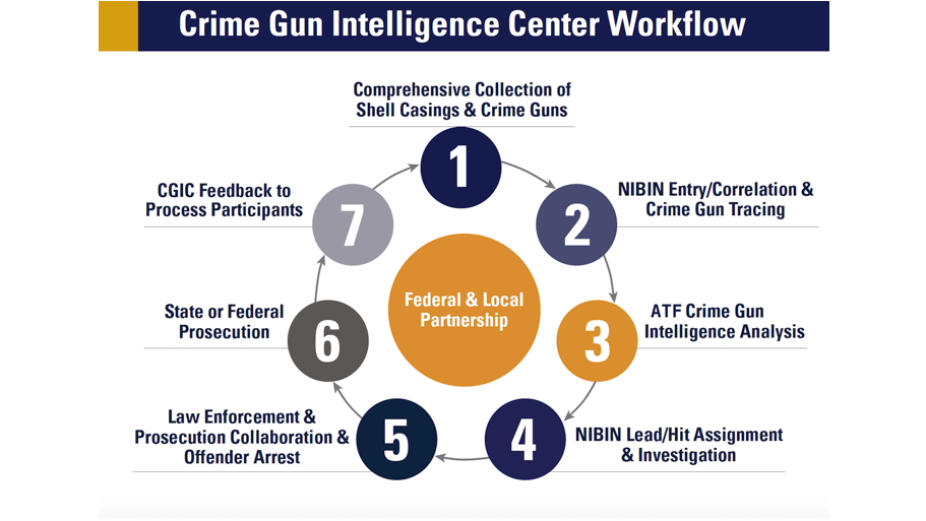Approach
A Crime Gun Intelligence Center (CGIC) is a model for reducing gun violence through multiagency (local and federal) collaboration focused on using various technologies to collect, manage, and analyze crime gun evidence in real time. A CGIC’s goal is to expedite the processing of this data in order to identify offenders and suspects for investigation and prosecution. CGICs are primarily a joint effort between local police agencies and the ATF. The CGIC model allows police to utilize multiple information systems to connect gun offenses and create investigative leads.1The Police Foundation, “The National Crime Gun Intelligence Center Initiative.” Crime Gun Intelligence Centers: Connecting the Dots. Last modified 2017. Accessed May 11, 2019. https://crimegunintelcenters.org/

Impact
The CGIC model aims to disrupt criminal activity and prevent future violence by identifying and prosecuting repeat violent offenders. Since this model has been in practice for only a few years and in limited locations, quantitative data on the success of CGICs is limited. However, qualitative information from established CGICs suggests a positive impact through an increase in investigative leads, arrests, and prosecutions for cases that are built using the CGIC model.2Police Executive Research Forum, “The Crime Gun Intelligence Center Model: Case Studies of the Denver, Milwaukee, and Chicago Approaches to Investigating Gun Crime”, Washington, DC: 2017. https://www.policeforum.org/assets/crimegunintelligencecenter.pdf
Other Benefits
CGICs provide valuable data to help identify crime gun sources, determine resource allocation for law enforcement, and increase police case-closure rates.
Necessary Resources
Local staffing would mainly come from law enforcement personnel. The number of law enforcement personnel needed varies by department/city; however, dedicating staff to the CGIC process is essential, as the number of investigative leads is expected to increase, thus increasing caseloads. Local police and prosecutors would likely designate existing personnel (most likely investigators and a dedicated crime gun prosecutor) to the program. If crime lab capability is available in-house, additional technicians may be necessary to process the higher volume of evidence being collected. Access to a crime lab with NIBIN equipment is required (in-house, state-run lab, or through the NIBIN National Correlation and Training Center). Using existing policing technology (e.g., ShotSpotter, surveillance cameras, license plate readers) is extremely beneficial to many of these investigations but not necessary to establish a CGIC.3Ibid.
Strategy in Practice
Overview
A CGIC is a circular model that operates around the use of NIBIN. NIBIN connects automated ballistic imaging systems so recovered ballistic evidence can be analyzed and compared across jurisdictions. Once an offense has occurred, all gun evidence must be collected from the scene (including bullets, shell casings, and guns). This evidence must be entered into an integrated ballistic identification system (IBIS) machine. These machines are strategically loaned out around the nation by the ATF. Once a technician uploads the evidence from the machine to NIBIN, the system can compare images and identify potential links to other crimes and submitted evidence in the region. The quicker a law enforcement agency can submit its evidence, the better the outcomes for developing leads in a case. Investigators must follow up immediately on the intelligence provided by the NIBIN analysis, as this information can quickly become obsolete. Law enforcement and prosecutors collaborate to determine the strength of a case and decide on offender arrest. As the investigation and/or case progresses, continuous feedback to all parties involved allows each contributor to know their role in the process, which is critical for buy-in and continued success of the model.4Crime Gun Intelligence Centers, “CGIC Concept,” accessed May 11, 2019, http://cgici.wpengine.com/cgic-concept/.
Common Barriers
Staffing and allotment of dedicated personnel to a CGIC may be challenging. Timing is key to the success of the model; therefore, personnel must make participation in the CGIC a priority. The CGIC model requires a continuous effort from all involved partners (i.e., law enforcement, ATF staff, crime lab personnel, etc.).
Additionally, successful CGICs utilize various technologies and systems, such as ShotSpotter, surveillance cameras, and license plate readers, to collect and analyze data. Obtaining and maintaining these technologies (including data storage capability and processes) can be costly and time-consuming.5Police Executive Research Forum, “The Crime Gun Intelligence Center Model”
Agencies, Organizations, and Other Necessary Partners
The primary agencies operating a CGIC are local law enforcement and the ATF. Supporting partners include local/state crime labs and prosecuting attorneys. Additional cooperation may come from probation and parole offices, surrounding local police jurisdictions, community groups, etc.6The Police Foundation, “The National Crime Gun Intelligence Center Initiative.”
What Else You Need to Know
Your local police agency must have access to NIBIN equipment either on-site or through a state crime lab with a timely turnaround (ideally within 48 hours). CGICs also utilize eTrace (an internet-based data entry system) to submit information for tracking the sale of crime guns.7Ibid.
Newsroom & Resources
-
Crime Gun Intelligence Centers
Comprehensive website describing CGIC purpose and process. Includes success stories, resources and technical assistance information.
-
Washington Post article from 2016 describing the establishment and use of NIBIN.
-
Local news article on CGIC being established in Indianapolis.
-
The “Crime Gun Intelligence Center” Model: Case Studies of the Denver, Milwaukee, and Chicago Approaches to Investigating Gun Crime
-
National Institute of Justice
The National Institute of Justice website provides an overview of NIBIN and related research.
-
Bureau of Alcohol, Tobacco, Firearms and Explosives (ATF): NIBIN
The Bureau of Alcohol, Tobacco, Firearms and Explosives (ATF) website provides brief description of NIBIN including resources for local law enforcement.
-
Bureau of Alcohol, Tobacco, Firearms and Explosives (ATF): CGICs
Bureau of Alcohol, Tobacco, Firearms and Explosives (ATF) website provides brief overview of Crime Gun Intelligence Centers.
-
Bureau of Justice Assistance
The Bureau of Justice Assistance website provides current funding and project information for CGICs.
-
The National Crime Gun Intelligence Governing Board: Crime Gun Intelligence
The Bureau of Alcohol, Tobacco, Firearms and Explosives (ATF) National Crime Gun Intelligence Governing Board’s 2018 best practices guide for implementing a crime gun intelligence program.